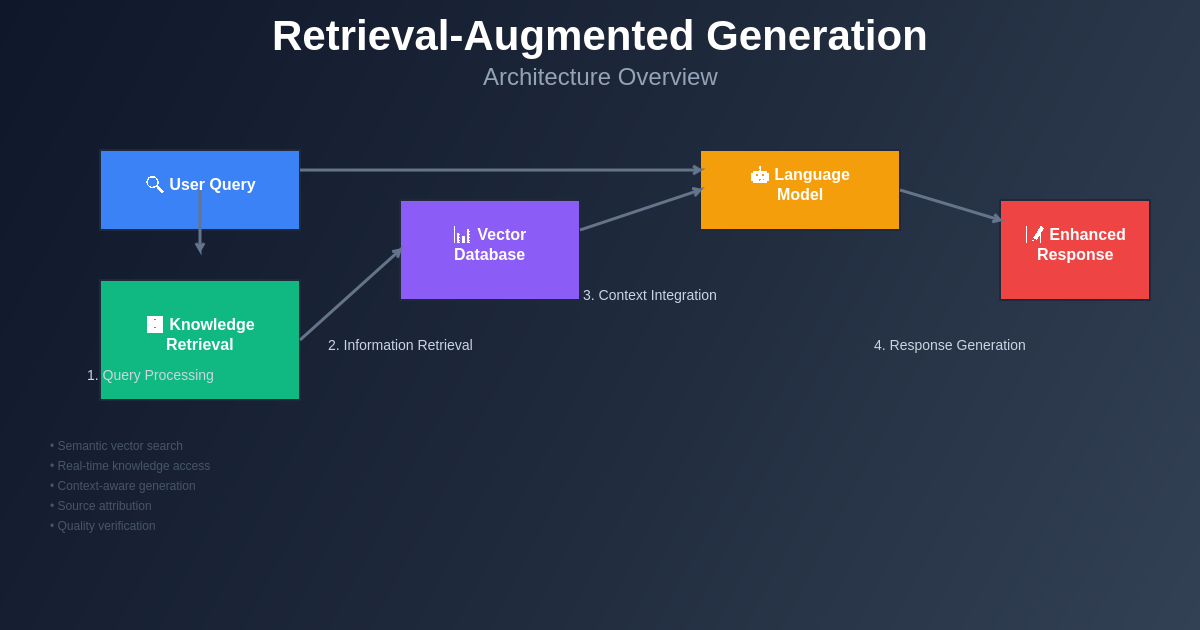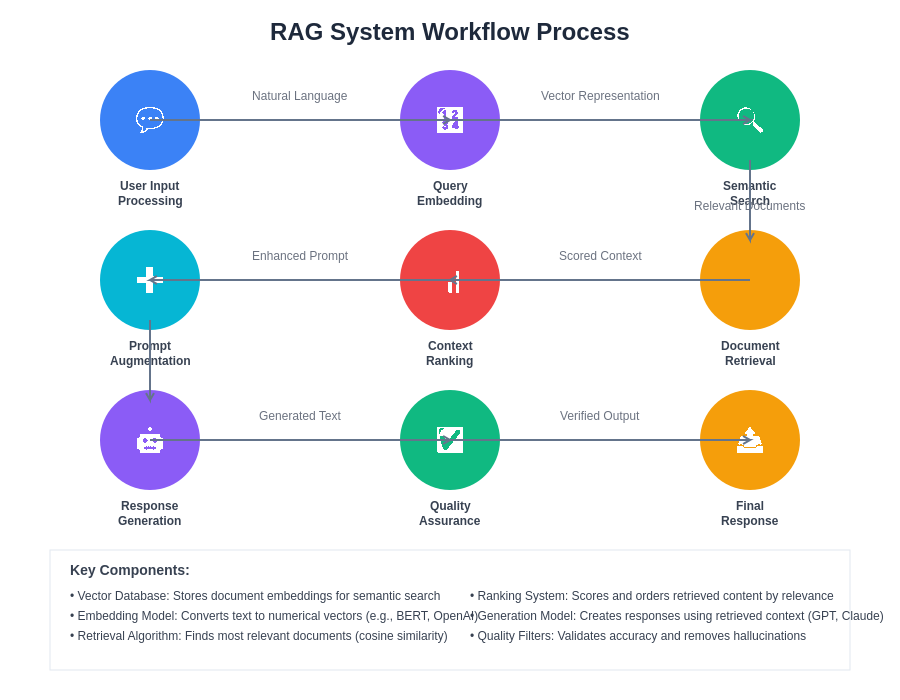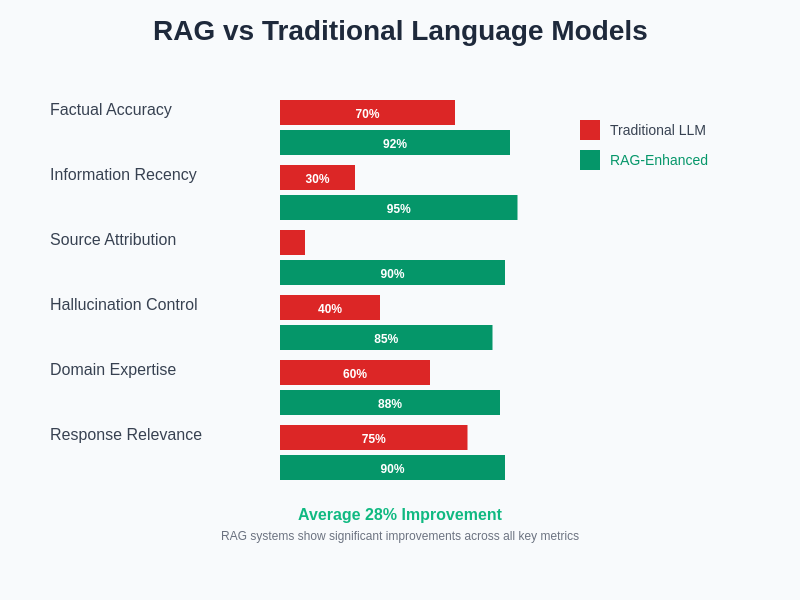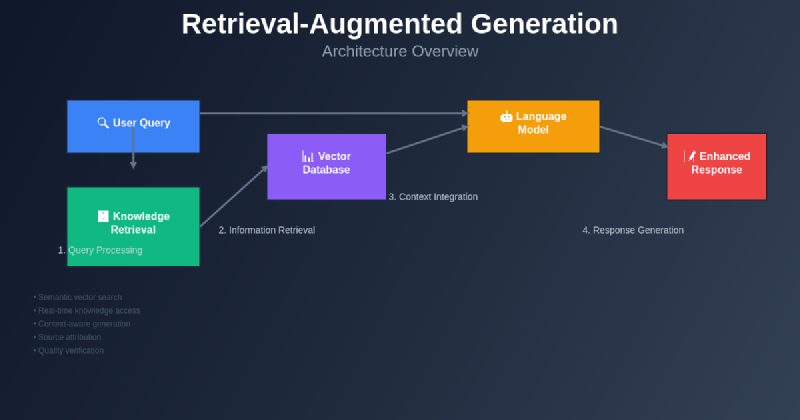Retrieval-Augmented Generation represents a groundbreaking advancement in artificial intelligence that addresses one of the most persistent challenges facing large language models: the limitation of static knowledge and the tendency to generate responses based solely on training data. This innovative approach combines the generative capabilities of advanced language models with dynamic information retrieval systems, creating AI systems that can access, process, and incorporate real-time information into their responses with unprecedented accuracy and relevance.
The emergence of RAG technology has fundamentally transformed how we approach AI-powered applications, enabling systems to provide responses that are not only linguistically sophisticated but also factually current and contextually appropriate. Stay updated with the latest AI developments to understand how RAG and similar technologies are reshaping the landscape of intelligent systems and creating new possibilities for human-AI collaboration across diverse industries and applications.
Understanding the Foundation of RAG Technology
Retrieval-Augmented Generation operates on a sophisticated architectural principle that seamlessly integrates two distinct but complementary AI capabilities: information retrieval and text generation. The retrieval component functions as an intelligent search system that can quickly identify and extract relevant information from vast databases, document collections, or knowledge repositories based on the specific context of a user’s query. This retrieved information is then fed into a generative language model that synthesizes this external knowledge with its own learned patterns to produce responses that are both coherent and factually grounded.
The technical implementation of RAG involves sophisticated vector databases that store information in high-dimensional semantic spaces, enabling the system to identify conceptually related content even when exact keyword matches are not present. This semantic understanding allows RAG systems to retrieve information that is contextually relevant rather than merely lexically similar, resulting in responses that demonstrate deeper comprehension of the underlying concepts and relationships within the queried domain.
The integration process between retrieval and generation components requires careful orchestration to ensure that the external information enhances rather than conflicts with the model’s inherent capabilities. Advanced RAG systems employ sophisticated ranking algorithms that evaluate the relevance and credibility of retrieved information, ensuring that only the most pertinent and reliable sources influence the final response generation process.

This comprehensive architecture demonstrates how RAG systems seamlessly integrate multiple components to deliver enhanced AI responses, combining the power of semantic search with advanced language generation capabilities to produce more accurate and contextually relevant outputs.
Addressing the Limitations of Traditional Language Models
Traditional large language models, despite their impressive capabilities, suffer from several inherent limitations that RAG technology effectively addresses. The most significant of these limitations is the static nature of their training data, which creates a knowledge cutoff beyond which the model cannot provide information about recent events, developments, or discoveries. This temporal limitation becomes particularly problematic in rapidly evolving fields such as technology, medicine, and current affairs, where information can become outdated within days or even hours.
Another critical limitation involves the phenomenon of hallucination, where language models generate plausible-sounding but factually incorrect information when they lack sufficient knowledge about a particular topic. RAG systems mitigate this issue by grounding responses in retrieved factual information, significantly reducing the likelihood of generating misleading or incorrect content. The external knowledge retrieval ensures that responses are anchored in verifiable sources rather than relying solely on patterns learned during training.
The specificity and depth of responses represent another area where traditional models often fall short, particularly when dealing with specialized domains or technical subjects that require precise, detailed information. RAG systems can access specialized databases and technical documentation, enabling them to provide responses with the level of detail and accuracy required for professional and academic applications.
Enhance your AI capabilities with advanced tools like Claude to experience how sophisticated reasoning combined with knowledge retrieval creates more powerful and reliable AI interactions. The combination of multiple AI technologies creates synergistic effects that amplify the capabilities of individual systems while maintaining high standards of accuracy and reliability.
The Technical Architecture of RAG Systems
The architecture of RAG systems involves several sophisticated components that work in concert to deliver enhanced AI responses. The retrieval component typically employs dense vector representations created through neural embedding models that capture semantic relationships between documents and queries. These embeddings enable the system to identify relevant information based on conceptual similarity rather than simple keyword matching, resulting in more nuanced and contextually appropriate retrievals.
The indexing process involves preprocessing large collections of documents or data sources, creating searchable representations that facilitate rapid information retrieval during query processing. Advanced RAG systems employ hierarchical indexing strategies that organize information at multiple levels of granularity, enabling both broad conceptual searches and highly specific factual lookups depending on the nature of the query and the required response detail.
The fusion mechanism between retrieved information and generative capabilities represents one of the most critical aspects of RAG architecture. This process involves sophisticated attention mechanisms that allow the language model to selectively incorporate relevant portions of retrieved information while maintaining coherence and fluency in the generated response. The integration process must balance the incorporation of external information with the model’s inherent knowledge to produce responses that are both informative and naturally readable.
Quality control mechanisms within RAG systems include source attribution, confidence scoring, and factual verification processes that help ensure the reliability of generated responses. These systems often implement multiple retrieval strategies and cross-validation techniques to verify information consistency across different sources before incorporating it into the final response.
Applications Across Industry Sectors
The versatility of RAG technology has enabled its adoption across numerous industry sectors, each benefiting from the enhanced accuracy and timeliness that retrieval-augmented responses provide. In the healthcare sector, RAG systems enable medical professionals to access up-to-date research findings, drug interactions, and treatment protocols while generating patient-specific recommendations that incorporate the latest medical knowledge and evidence-based practices.
Financial services organizations leverage RAG technology to provide real-time market analysis, regulatory compliance information, and investment recommendations that reflect current market conditions and regulatory requirements. The ability to incorporate live financial data and recent market developments into AI responses has proven invaluable for financial advisory services and automated trading systems that require accurate and timely information for decision-making.
Legal professionals utilize RAG systems to access vast databases of case law, legal precedents, and regulatory changes, enabling AI-powered legal research that can quickly identify relevant cases and legal principles while generating comprehensive legal analyses that incorporate the most recent judicial decisions and statutory changes. This application has significantly accelerated legal research processes while improving the comprehensiveness and accuracy of legal document preparation.
Educational technology platforms employ RAG systems to create personalized learning experiences that can access current educational content, research findings, and pedagogical resources to generate customized learning materials and explanations tailored to individual student needs and learning objectives. The dynamic nature of RAG enables educational AI to stay current with evolving curricula and educational best practices.
Enhancing Customer Service and Support Systems
Customer service represents one of the most impactful applications of RAG technology, where the combination of conversational AI with real-time access to product information, troubleshooting guides, and company policies creates support systems that can provide accurate and helpful assistance across a wide range of customer inquiries. RAG-powered customer service systems can access product manuals, FAQ databases, and support tickets to generate responses that are both contextually appropriate and factually accurate.
The implementation of RAG in customer support enables systems to handle complex technical inquiries that require specific product knowledge or troubleshooting procedures while maintaining the natural conversational flow that customers expect from modern AI assistants. These systems can retrieve relevant documentation, warranty information, and step-by-step procedures to guide customers through resolution processes effectively.
The scalability benefits of RAG in customer service are particularly significant, as organizations can maintain comprehensive support capabilities without requiring extensive human intervention for routine inquiries. The system’s ability to access updated product information and support procedures ensures that customer responses remain accurate even as products and services evolve.
Explore advanced AI research capabilities with Perplexity to understand how comprehensive information retrieval enhances the quality and accuracy of AI-powered research and analysis across various domains and applications.
Improving Content Creation and Knowledge Work
Content creation has been revolutionized by RAG technology, enabling writers, researchers, and content creators to generate materials that incorporate the most current information and diverse perspectives on their topics. RAG systems can access recent publications, research papers, and news articles to ensure that generated content reflects the latest developments and maintains factual accuracy throughout the creation process.
The research capabilities enabled by RAG technology have transformed how knowledge workers approach information gathering and analysis tasks. Instead of manually searching through multiple sources and synthesizing information, professionals can leverage RAG systems to automatically retrieve and integrate relevant information from diverse sources while generating comprehensive analyses and reports that would traditionally require extensive manual research.
The accuracy and reliability improvements in content creation are particularly significant for technical writing, journalism, and academic work, where factual precision and currency of information are paramount. RAG systems can verify facts across multiple sources and incorporate diverse perspectives to create more balanced and comprehensive content while maintaining the efficiency benefits of AI-assisted creation.
The collaborative aspects of RAG-enhanced content creation enable human creators to focus on creative and strategic elements while relying on the system to handle information gathering and factual verification tasks. This division of labor optimizes both human creativity and machine efficiency to produce superior outcomes compared to either approach used independently.
Technical Implementation Strategies and Best Practices
Implementing RAG systems requires careful consideration of several technical factors that significantly impact system performance and effectiveness. The choice of embedding models affects the quality of semantic matching between queries and retrieved information, with different models optimized for various types of content and domain-specific applications. Organizations must evaluate embedding models based on their specific use cases and content characteristics to achieve optimal retrieval performance.
Database architecture and indexing strategies play crucial roles in determining the speed and accuracy of information retrieval within RAG systems. Vector databases must be optimized for high-dimensional similarity searches while maintaining acceptable query response times even with large-scale document collections. Advanced indexing techniques such as hierarchical clustering and approximate nearest neighbor algorithms help balance retrieval accuracy with computational efficiency.
The integration of multiple data sources requires sophisticated data preprocessing and normalization procedures to ensure consistency and compatibility across different information formats and structures. RAG systems must handle various document types, metadata schemas, and content formats while maintaining the semantic coherence necessary for effective retrieval and generation processes.
Quality assurance mechanisms include automated fact-checking procedures, source verification protocols, and response evaluation metrics that help maintain high standards of accuracy and reliability in generated responses. These systems often employ multiple validation approaches to verify information consistency and detect potential contradictions or inaccuracies before presenting information to users.

The detailed workflow process illustrates the systematic approach RAG systems employ to transform user queries into enhanced responses, showcasing each critical step from initial input processing through final quality assurance and output generation.
Challenges and Limitations in RAG Implementation
Despite its significant advantages, RAG technology faces several implementation challenges that organizations must address to achieve successful deployments. The computational overhead associated with real-time information retrieval can impact system response times, particularly when dealing with large-scale document collections or complex queries that require extensive search operations. Optimization strategies must balance retrieval comprehensiveness with acceptable performance characteristics for user-facing applications.
Data quality and source reliability represent critical challenges in RAG implementation, as the accuracy of generated responses directly depends on the quality of retrieved information. Organizations must implement robust content curation and source verification processes to ensure that their RAG systems access reliable and authoritative information sources while filtering out outdated, biased, or inaccurate content.
The integration complexity between retrieval and generation components requires sophisticated engineering approaches to ensure seamless operation and optimal performance. Different language models may require specific integration strategies, and the tuning of retrieval parameters must be carefully balanced to avoid overwhelming the generation process with excessive or irrelevant information while ensuring comprehensive coverage of relevant topics.
Privacy and security considerations become particularly important in RAG implementations that access sensitive or proprietary information sources. Organizations must implement appropriate access controls, data encryption, and audit trails to ensure that information retrieval processes comply with regulatory requirements and organizational security policies while maintaining the functionality benefits of enhanced AI responses.
Future Developments and Emerging Trends
The evolution of RAG technology continues to accelerate with advancing capabilities in neural information retrieval, multimodal integration, and real-time knowledge updating systems. Emerging approaches combine traditional text-based retrieval with image, audio, and video content processing, enabling more comprehensive and versatile AI systems that can incorporate diverse types of information into their responses.
The integration of RAG with specialized AI models for different domains promises to create more sophisticated systems that can provide expert-level responses across multiple fields simultaneously. These developments include domain-specific embedding models, specialized retrieval algorithms, and tailored generation approaches that optimize performance for particular industries or applications.
Real-time knowledge graph integration represents another significant advancement in RAG technology, enabling systems to access structured knowledge representations that provide not only factual information but also complex relationships and contextual connections between different concepts and entities. This integration enhances the depth and sophistication of AI responses by incorporating rich semantic relationships into the generation process.
The democratization of RAG technology through improved tooling and platforms is making these capabilities accessible to smaller organizations and individual developers, potentially accelerating innovation and adoption across diverse applications and use cases. Open-source RAG frameworks and cloud-based solutions are reducing the technical barriers to implementation while maintaining the performance and accuracy benefits of enterprise-grade systems.
Measuring Success and Performance Optimization
Evaluating the effectiveness of RAG systems requires comprehensive metrics that assess both the quality of information retrieval and the coherence of generated responses. Traditional information retrieval metrics such as precision and recall must be combined with natural language generation evaluation approaches to provide holistic assessments of system performance across different types of queries and applications.
User satisfaction metrics play crucial roles in RAG system evaluation, as the ultimate success of these systems depends on their ability to meet user needs and expectations effectively. Organizations must implement feedback collection mechanisms and user experience monitoring to continuously improve their RAG implementations based on real-world usage patterns and outcomes.
Performance optimization strategies for RAG systems involve iterative refinement of retrieval algorithms, generation parameters, and integration mechanisms based on performance data and user feedback. A/B testing approaches enable organizations to compare different configuration options and identify optimal settings for their specific use cases and user requirements.

The quantitative comparison demonstrates RAG systems’ superior performance across critical metrics, showing substantial improvements in factual accuracy, information recency, source attribution, and hallucination control compared to traditional language model approaches.
The continuous learning capabilities of RAG systems enable ongoing improvement through feedback incorporation and knowledge base updates. These systems can learn from user interactions and feedback to refine their retrieval strategies and generation approaches, creating adaptive systems that improve over time while maintaining consistency and reliability in their responses.
Integration with Existing AI Ecosystems
The successful integration of RAG technology with existing AI and software ecosystems requires careful planning and architectural consideration to ensure compatibility and optimal performance across different system components. API design and integration protocols must facilitate seamless communication between RAG components and existing applications while maintaining security and performance requirements.
The scalability considerations for RAG integration involve both horizontal scaling of retrieval components and vertical optimization of generation processes to handle varying loads and usage patterns effectively. Organizations must plan for growth in both user base and knowledge base size while maintaining acceptable response times and accuracy levels.
Workflow integration strategies help organizations incorporate RAG capabilities into existing business processes and user workflows without disrupting established practices or requiring extensive retraining. The design of user interfaces and interaction patterns must balance the enhanced capabilities of RAG systems with familiar user experience patterns to facilitate adoption and effective utilization.
The compatibility requirements for RAG integration include consideration of different data formats, API protocols, and security frameworks that may be present in existing organizational technology stacks. Successful integration often requires custom development work to bridge differences between RAG capabilities and existing system requirements while preserving the benefits of enhanced AI responses.
Retrieval-Augmented Generation represents a transformative advancement in artificial intelligence that addresses fundamental limitations of traditional language models while opening new possibilities for intelligent applications across diverse industries and use cases. The combination of sophisticated information retrieval with advanced text generation creates AI systems that are both more accurate and more useful for real-world applications, marking a significant step forward in the evolution of practical artificial intelligence solutions. As this technology continues to mature and evolve, its impact on how we interact with and benefit from AI systems will likely become even more profound, reshaping our expectations of what intelligent systems can accomplish and how they can enhance human knowledge work and decision-making processes.
Disclaimer
This article is for informational purposes only and does not constitute professional advice. The views expressed are based on current understanding of RAG technology and its applications. Readers should conduct their own research and consider their specific requirements when implementing RAG systems. The effectiveness and suitability of RAG technology may vary depending on specific use cases, technical requirements, and organizational contexts.
